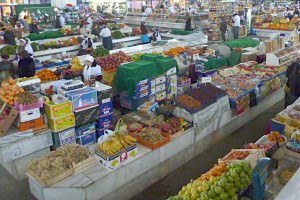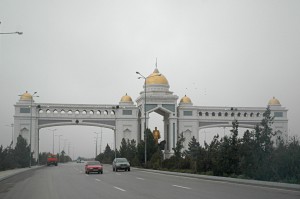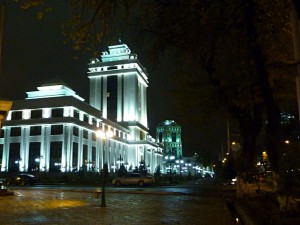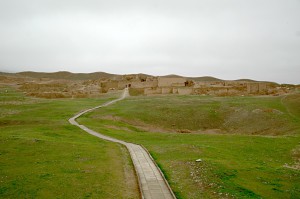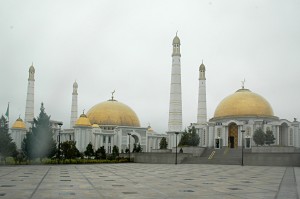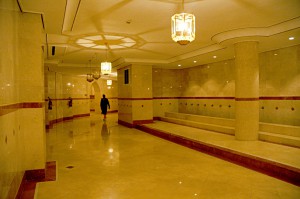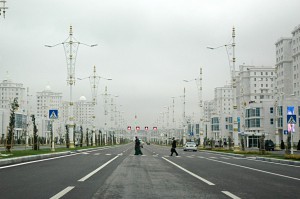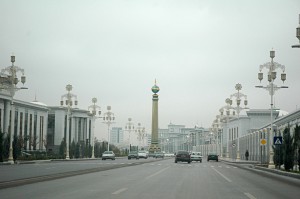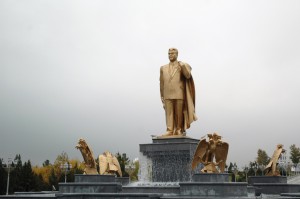On Tuesday it was time for my next border crossing. The first one which required applying for a visa on the way. Past gthe border a whole different world was waiting for me: Ashgabat, the Turkmen capital.
To visit Turkmenistan as a tourist, there are two alternatives: either applying for a transit visa with a maximum validity of 5 days or applying for a tourist visa with a longer validity and the requirement of booking an organized tour and guide. since I wanted to visit the country for more than 5 days, I opted for the second alternative. The travel agency Ashgabatsiyakhat and its manager Artyk had made a good suggestion for an intinerary for an acceptable price. The price was still high, but almost half the price a competitor offered. The letter of invitation was organized by the travel agency and sent to me via e-mail. Unfortunately, due to the celebration of the Turkmen independence day on October 27, the letter took several weeks to process, such that I could not apply for the visa in Germany. I tried to get the visa in Ankara, but the 4 days it took to process the visa made me change my mind and apply for the visa at the border.
I left my hotel well before 10am, since I had told Artyk, I would be at the Iranian side of the border by 10am. Between Iran and Turkmenistan there is a time difference of an hour and a half. Due to this time difference he asked the driver to wait for me at noon Turkmen time. I estimated that this would probably be quite optimistic considering the fact, that I had to get a visa before being allowed to cross the border and there were 25km drive by minibus between the border and the meeting point.
Leaving Iran alone took more than 15 minutes, since my passport had to be checked four times. The real delay however was produced at the Turkmen side of the border. At the first passport control, the young soldier left my passport to be processed last, since he had no idea where I was from. The red passport with the white cross and the name of the country in five languages was not enough for him to understand where I was from. Fortunately I was able to tell him the correct name in almost his language.
The next step was to enter the border control building and to turn in my passport and the letter of invitation to the next friendly fellow. After an extended period, I was called to the desk again to retrieve a payment slip, which I had to carry to another door which was the “bank”, where I had to pay the visa and entry fees. Of course the bank was not open, when everybody was ready to make the payment, but we had to wait another 10 to 15 minutes before we could make our payment. I tried to get rid of some older bank notes, but whenever encountering an older note or one that was partially ripped, the lady said “problem” and requested a replacement.
Once I had paid the visa and entry fees, I had to wait until my name was called again and I could turn one copy of the payment receipts to get my passport with the visa back. This allowed me to queue for border crossing. At the first possibility I handed over my passport and waited again until I was called. I could then put my backpack on the x-ray machine and afterwards still had to open it, since the customs officer wanted to look inside and was interested whether I had any drugs or bombs in my backpack. He was most fascinated by my hat in the end, but I kept it and could finally board the minibus to the arranged meeting point. It takes about 5 minutes per person to pass the border, which almost made a few Iranian lose their temper. They asked me, how much time it took me to enter Iran. Definitely less, since most of the time I was sleeping on the train.
I finally met Berdy my driver for this and the following day at the check point, where the poor fellow had been waiting for me for two hours. He quickly drove me to Ashgabat and dropped me at my hotel off. 10 minutes later, Artyk arrived at the hotel and we spoke about my program for the following days and clarified last formalities. For the registration with the government he need two mug shots and my passports. About an hour later, after I had finally eaten something, he had everything ready and I got my passport back. Being liberated I started out into the city and managed to be straightened out where not to take pictures in my very first try to take a picture. My second success of the night was being sent away by a soldier from the president’s palace.
The first impressions of the city were overwhelming. All the governmental buildings are built from marble, sometimes even the condominiums. The roads are wide boulevards, even though there is not really a lot of traffic. In front of some of the marble buildings there are fountains which are lit in changing colors, all synchronized along several hundred meters. The buildings are wonderfully illuminated at night, a photographers paradise. If he was allowed to take pictures. At one point I asked a soldier whether I was allowed to walk down a certain street, which he answered with yes. But he immediately countered my question with his own: whether I had any cigarettes for him. The wide sidewalks are almost deserted. I therefore had the feeling that with every step I was doing something illegal. Crazy world!
Since my hotel does not offer any breakfast, I had to find breakfast somewhere else. At 9am I met Elena, the German speaking guide for Wednesday for Ashgabat and Berdy the driver. Since there was a change of time zone between Iran and Turkmenistan, I did not wake up as usually around 7am, but around 8:30am. That meant, I had to leave out breakfast for the day. Fortunately I had had a good dinner the night before, such that my hunger was not too bad. Next time I am crossing over a time zone, I will definitely set my alarm clock.
Berdy drove us up and down the city of Ashgabat according to the set program. First destination was the old fortress of Nisa, north-west of city. Nisa is an old fortress built of mud-bricks, similar to what I had seen in Kashan and Meybod in Iran. The difference here is that excavations are still underwhy and the later history, after the Zoroaster, has not been clearly identified yet. Roman and Greek statues have been found, which even complicates clear statements of the prupose of the site.
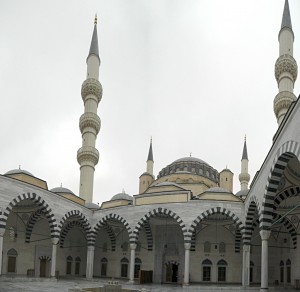
From Nisa we headed to the mausoleum of Turkmenbashi, the father of the Turkmen people, the first and former president Nyazov. During Sowjet times he was communist and later led Turkmenistan into independence. He then rewrote history in his own book, Ruhmanna, which now serves as official history book in all schools of the country. The excentric president let himself build many golden statues all over the city, which are now slowly being removed to be setup at a memorial site later on. He built his mausoleum while still alive like the ancient kings had done. According to official records the cost for the mausoleum and the adjacent mosque amounts to 40 million US dollars, all built in finest marble and decorated in gold. Anyone who has seen the site doubts the this amount is enough to pay for all there is. The mosque offers room for 10’000 people praying at the same time and a sub-terreanen garage for 20’000 cars. Next to the buildings, there is a pic-nic site with a special cooking place, where in summer the locals enjoy their days off. But the mosque is not used by muslims, since all except for one inscriptions are citations from Nyazov’s history book Ruhmanna and not from the Quran. At least I was allowed to take a few pictures from the outside, the guardian indicated that there were too many surveillance cameras on the inside.
We then drove to a mosque which is actually used in the city, a replica of the Blue Mosque of Istanbul. Even though the two mosques are not identical, the similarities are definitely there. Only difference: where the Blue Mosque was full of visitors, there is exactly one person in the Turkmen mosque. Otherwise the place is deserted, even though it apparently is actively used. Elena prefers to stay outside and smoke a cigarette, even though illegal in Turkmenistan. The current president was a dentist and knows about the consquences of smoking, which is why he prohibited it.
For lunch we drove to shopping center with among others a self-service restaurant. The food was good, but for Turkmen standards expensive. I payed the equivalent of 11 US dollars, while Elena chose to only drink a coffee. The food is probably too expensive for her. Berdy had explained to me the day before, that as a physician he had made 400 dollars per month even though he was also vice-president of the red half moon in Turkmenistan. In the meantime he works as an independent consultant recommending to pharmacists which medicine to buy and working as driver for tourist agencies.
In the afternoon we visited the marble parts of the city. I wonder how much money Turkish and French construction companies make by building all the buildings and monuments. The marble is important from Turkey, where the majority of the construction companies are from. It therefore comes as no surprise that the only foreign trucks I saw on the Iranian side of the border were Turkish.
Elena and Berdy did a great job in explaining which building contained which minitry or which were appartment buildings. Interesting indeed, which ministries there are in Turkmenistan. For example there is a Ministry of Carpets and a Ministry of Horses. The employees of these ministries can buy the appartments in the marble buildings for a better price and a financing plan for 30 years. There are further interesting buildings in the city, like the Wedding Palace or the Olympic Town for some central Asian games in 2017. In total the are 7 stadiums in the Ashgabat. On our tour we pass the independence monuments as well as the memorial for 10 years of independence. Repeatedly we pass the President’s Palace around which taking pictures is not allowed. The train station apparently is also a strategically important point of which no pictures may be taken.I was dropped off at the hotel in the late afternoon, after Elena and Berdy had shown me a nice restaurant where I could eat dinner. I thanked the two of them and first had to go to my hotel room and relax after a strange and surreal day in the Turkmen capital.

